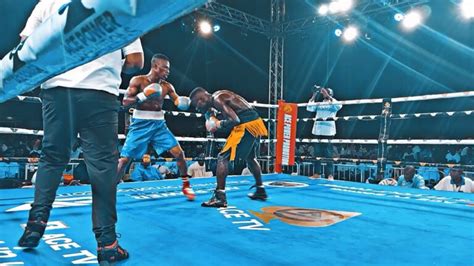Discover key techniques for analyzing boxing opponents, gather valuable data on their styles, and develop strategies to enhance your performance in the ring.In the fiercely competitive world of boxing, success often hinges on more than just physical prowess; it requires an astute understanding of your opponent. “How to Analyze Your Opponent: Strategies for Success” delves into the essential skills every boxer must cultivate to stay ahead in the ring. By mastering the art of opponent analysis, fighters can identify strengths and weaknesses, craft informed strategies, and adapt their tactics in real-time during matches. This article explores the importance of analyzing opponents, offers key techniques for effective data gathering, and discusses how to evaluate performance post-fight. Elevate your boxing game and gain the competitive edge by learning how to read your adversary like a seasoned pro. With the right strategies in hand, victory is not just a possibility—it’s an expectation.
Understanding The Importance Of Analyzing Opponents In Boxing
Analyzing your opponents in boxing is a critical aspect of preparation that can significantly influence the outcome of a match. The importance of analyzing opponents in boxing cannot be overstated, as it helps fighters anticipate their opponent’s moves, exploit their weaknesses, and develop a strategic approach tailored to the unique attributes of each opponent.
One of the primary reasons analyzing opponents in boxing is vital is that boxing is not just about brute strength; it’s also about strategy and intelligence. By understanding an opponent’s fighting style, tendencies, and physical characteristics, a boxer can make informed decisions in the ring, leading to more effective counters and offensive maneuvers.
Moreover, detailed analysis enables boxers to identify patterns in their opponent’s behavior. For example, recognizing when and how an opponent typically throws their power punches can allow a fighter to prepare defensively—staying out of range or anticipating a counterattack. This foresight can often be the difference between victory and defeat in a close match.
Furthermore, analyzing video footage of past fights can provide invaluable insight. Fighters can break down specific rounds, focusing on their opponent’s footwork, head movement, and defensive tactics. This analysis allows them to develop effective game plans, ensuring they are not caught off guard during the bout.
Effective analyzing opponents in boxing equips fighters with the knowledge and tools necessary to perform at their best. It lays the groundwork for strategic development and enhances a boxer’s ability to adapt, both in the lead-up to the fight and during the action itself. The more a boxer understands their opponent, the better positioned they will be to seize the upper hand in the ring.
Key Techniques For Effective Opponent Analysis
Analyzing opponents in boxing is a crucial step towards enhancing your own performance and increasing your chances of success in the ring. Here are some essential techniques to help you effectively analyze your opponent:
| Technique | Description |
|---|---|
| Film Study | Review fight footage to observe your opponent’s fighting style, techniques, and patterns. Pay attention to their stance, movement, and key strengths. |
| Footwork Analysis | Analyze how your opponent moves in and out of range. Consider their lateral movement and whether they prefer attacking or countering while on the move. |
| Punching Patterns | Take note of your opponent’s usual combinations and favorite punches. Identify if they have any predictable habits that you can exploit. |
| Defensive Techniques | Observe how your opponent defends against attacks. Look for gaps in their guard and tendencies in situations where they may leave themselves vulnerable. |
| Physical Attributes | Consider your opponent’s height, reach, and overall physical conditioning. This information will help you determine how to approach the fight strategically. |
By employing these techniques when analyzing opponents in boxing, you can build a comprehensive understanding of their capabilities and prepare an effective game plan tailored to exploit their weaknesses. Stay observant and adaptable, which are key traits for any successful boxer.
Gathering Valuable Data On Opponent Fighting Styles
When it comes to analyzing opponents in boxing, collecting detailed information on their fighting styles is crucial. Understanding your opponent’s tendencies, strengths, and weaknesses can greatly enhance your chances of success in the ring. Here are several effective strategies for gathering valuable data:
- Watch Fight Footage: One of the most effective ways to gather data is to study previous fights. Analyze video footage to observe how your opponent reacts under different circumstances, and identify their signature moves.
- Assess Their Training Methods: If possible, watch your opponent during their training sessions. Noting their preparation can provide insights into their tactics, conditioning, and how they adapt their style based on past opponents.
- Interview Others: Talk to fellow boxers, trainers, or analysts who have faced your opponent. Their perspectives can offer valuable insights that may not be apparent from just watching fights.
- Utilize Statistical Analysis: Keep track of key statistics from your opponent’s fights, such as punch accuracy, defensive capabilities, and frequency of certain types of punches. This data can reveal patterns that may be advantageous for your fight strategy.
- Evaluate Their History: Review your opponent’s fight record to identify trends. Have they performed well against aggressive fighters? Do they struggle against counter-punchers? Understanding their historical performance provides context for your strategy.
By employing these techniques, you’ll be better equipped to make informed decisions during your training and in the ring, ultimately leading to more effective analyzing opponents in boxing and improved performance. Remember, the more data you gather, the better prepared you will be to exploit your opponent’s weaknesses and maximize your chances of victory.
Developing A Strategy Based On Opponent’s Weaknesses
Once you have successfully gathered information about your opponent’s fighting style and identified their weaknesses, it’s time to formulate a strategy that will capitalize on those vulnerabilities. Effective analyzing opponents in boxing not only reveals areas to exploit but also guides your tactical approach throughout the match.
Start by prioritizing the weaknesses you’ve observed. For example, if you notice that your opponent struggles with defending against body shots, incorporate these attacks into your game plan. Here are some key strategies to consider:
- Targeted Attacks: Focus on specific areas that your opponent has demonstrated susceptibility to. Whether it’s a lack of head movement or poor footwork, aim your punches where they will be most effective.
- Feints and Deceptions: Utilize feints to create openings. If your opponent is overcommitted to guarding a particular area, they may leave other areas exposed, allowing you to land significant strikes.
- Adapting Your Style: Modify your boxing style to take advantage of your opponent’s weaknesses. If they are a power puncher but have poor stamina, consider adopting a defensive strategy that forces them to expend more energy while you look for opportunities to counter.
- Game Plan Flexibility: Be prepared to adjust your strategy as the fight progresses. If your opponent begins to adapt to your initial approach, quickly pivot to alternative strategies that continue to exploit their weaknesses.
Incorporating these tactics requires thorough preparation and practice. Rehearse your game plan during training, simulating the fight scenario as much as possible. This way, you can act confidently and instinctively during the match, knowing you have a solid strategy rooted in your analyzing opponents in boxing.
Keep in mind the importance of psychological factors. Understanding how your opponent reacts under pressure can also inform your strategy. A well-founded game plan that leverages their weaknesses while capitalizing on your strengths will give you a significant edge in the ring.
Implementing Tactical Adjustments During The Fight
When you’re in the ring, the ability to adapt quickly is crucial for success. Analyzing opponents in boxing goes beyond pre-fight preparation; it’s about making real-time adjustments based on what you observe during the match. Here are some key strategies for implementing tactical adjustments:
- Stay Observant: Keep a close watch on your opponent’s movements and reactions. Are they favoring a particular hand? Do they retreat or become aggressive after certain punches? Staying observant allows you to identify tendencies that you can exploit.
- Communicate with Your Corner: Your trainer and corner team provide vital feedback. They can see angles and patterns that you might miss. Don’t hesitate to listen to their advice and adjust your approach based on their insights.
- Change Your Rhythm: If your opponent is timing your strikes, mix up your pace and rhythm. Throw in feints or alter the speed of your punches to disrupt their timing and create openings.
- Adjust Your Range: Evaluating the distance from which you’re engaging can be game-changing. If your opponent excels at long-range punches, consider closing the distance to nullify their advantages and force them into your fight.
- Recognize and Target Weaknesses: If your opponent shows signs of fatigue or has difficulty with defense against specific punches, tailor your strategy to capitalize on these weaknesses as the fight progresses.
Incorporating these adjustments will not only enhance your performance during the match but also empower you to be a more strategic and adaptive fighter. Remember, the ability to adjust your tactics in the heat of battle is a hallmark of a great boxer, underscoring the value of analyzing opponents in boxing not just before, but during the fight as well.
Evaluating Your Performance After Analyzing Opponents in Boxing
Once the match is finished and the adrenaline begins to settle, it is crucial to take a step back and evaluate your performance, especially in the context of analyzing opponents in boxing. This reflection can be vital for your growth as a boxer and for preparing for future matches.
Start by reviewing the fight footage to assess your effectiveness in applying the strategies developed from your opponent analysis. Pay attention to how well you exploited their weaknesses and whether you were able to implement your tactical adjustments successfully during the bout.
Next, consider the following aspects:
- Strategic Execution: Did you adhere to your game plan based on your analysis? Identify specific moments where you succeeded or deviated from the strategy.
- Adaptability: How quickly were you able to adjust your tactics in response to your opponent’s actions? Reflect on whether you responded effectively to any changes in their approach.
- Defensive Maneuvers: Analyze your defensive performance when facing your opponent. Were you able to counter their strengths? Did you leave yourself vulnerable at any point?
- Conditioning: Consider your physical endurance and readiness for the match. Did fatigue impact your ability to execute strategies? Make a note of any conditioning areas that need improvement.
Gather feedback from trainers and peers who witnessed the match. Their perspectives can provide valuable insights that you may not have considered. Incorporating this feedback into your training sessions will enhance your ability to analyze opponents in boxing more effectively in future bouts.
Frequently Asked Questions
Why is it important to analyze your opponent?
Analyzing your opponent helps you understand their strengths and weaknesses, allowing you to develop effective strategies to counter their moves and improve your chances of success.
What are some key areas to focus on when analyzing an opponent?
Key areas to focus on include their playing style, past performance, decision-making patterns, and psychological tendencies during stressful situations.
How can I gather information about my opponent?
You can gather information through research, observation of past matches, reviewing video footage, and discussing strategies with coaches or teammates who have faced them.
What role does psychological analysis play in understanding my opponent?
Psychological analysis helps you gauge your opponent’s mindset, including their confidence levels and emotional responses, which can inform your tactical approach during competitions.
Are there specific tools or techniques to analyze opponents effectively?
Yes, techniques may include performance metrics analysis, scouting reports, and using software designed for sports analytics to identify patterns and trends in your opponent’s gameplay.
How can I apply the insights gained from my analysis during a match?
Use the insights to formulate your game plan, adapt your strategies in real-time, and exploit your opponent’s weaknesses while reinforcing your strengths.
Is opponent analysis just for team sports, or can it be applied to individual sports as well?
Opponent analysis is beneficial in both team and individual sports, as understanding your competitor’s tactics and strategies can enhance your performance in any competitive scenario.









